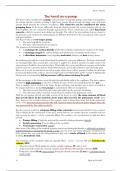Summary
Summary The heart as a pump
- Course
- Institution
Discover the heart's intricacies as a pulsatile pump, orchestrating blood circulation. From atrial-ventricular coordination to cardiac valve mechanics, delve into its dynamic function. Unravel the cardiac cycle's mysteries, from diastolic filling to systolic contraction. Learn about heart sounds...
[Show more]



